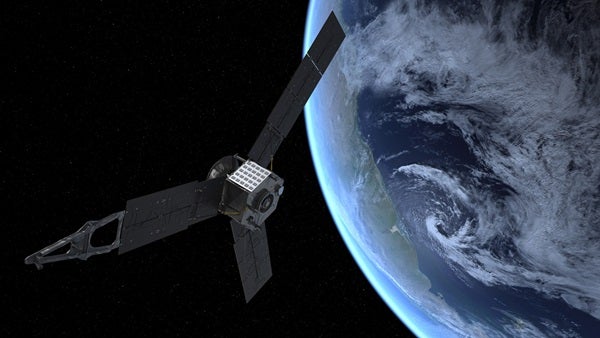Watch the flyby below live thanks to SLOOH.com! Coverage begins at 01h30m UT (9:30 p.m. EDT).
As the largest planet in our solar system, Jupiter grabbed most of the leftover mass after the Sun formed. Juno is seeking to answer some fundamental questions about the gas giant and, in turn, about the processes that led to the formation of our solar system. Jupiter is in the outer solar system, about five times as far away from the Sun as Earth.
“Juno is a large, massive spacecraft,” said Scott Bolton of Southwest Research Institute and the principal investigator of the Juno miss. The spacecraft has three large solar panels, measuring 9 by 29 feet (2.7 by 8.8 meters), and a titanium vault to protect sensitive electronics from the harsh environment around Jupiter. “Even a large rocket couldn’t provide enough propulsion to get us all the way to Jupiter, so we are flying by the Earth for a gravity assist that will provide about 70 percent of the initial boost provided by the Atlas V 551 rocket. The gravity assist essentially provides as much propulsion as second rocket launch,” Bolton said.
The Juno spacecraft was launched toward Jupiter from Kennedy Space Center on August 5, 2011. The rocket provided Juno enough speed to reach the asteroid belt, at which point the Sun’s gravity pulled it back toward the inner solar system. The Earth flyby gravity assist increases the spacecraft’s speed relative to the Sun from 78,000 mph (126,000 km/h) to 87,000 mph (140,000 km/h).
“While we are primarily using Earth as a means to get us to Jupiter, the flight team is also going to check and calibrate Juno’s science instruments,” said Bolton. “As another bonus, Juno is approaching the Earth from deep space, from the sunlit side. Juno will take never-before-seen images of the Earth-Moon system, giving us a chance to see what we look like from Mars or Jupiter. We plan to release a movie of this unique perspective of the Earth-Moon system shortly after the flyby.”
Juno will arrive at Jupiter on July 4, 2016. Once in orbit around the giant world, the spacecraft will circle the planet 33 times, from pole to pole, and use its collection of nine science instruments to probe beneath the gas giant’s obscuring cloud cover. Juno’s science team will learn about Jupiter’s origins, structure, atmosphere, and magnetosphere, and look for a potential planetary core.










